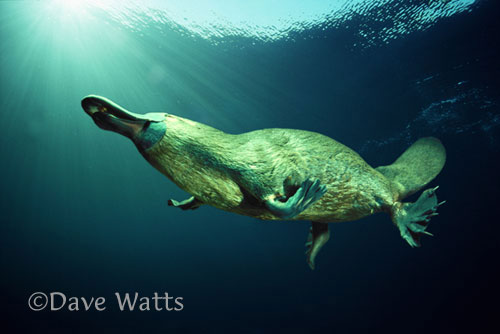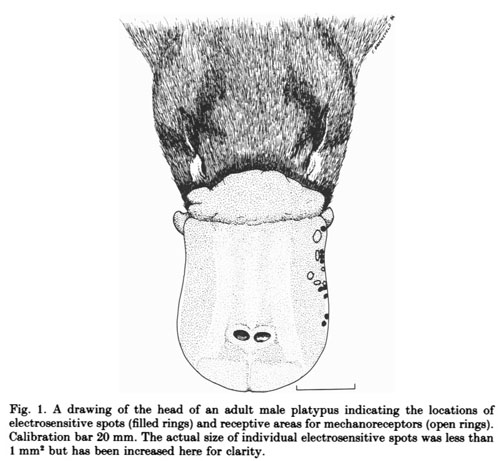Electroreception in Platypus (Ornithorhynchus anatinus)
Biology 342 Fall 2010
Author:
Emily Fong
| Home | Phylogeny | Ontogeny | Mechanism | Adaptative Value | References | Course Home |
The Amazing Sensory Perception of Platypus

Photo Copyright Dave Watts Wildlife Photography
Learning Through Electroreception
The platypus (Ornithorhynchus anatinus) is semi-aquatic mammal endemic to eastern Australia and Tasmania. As a member of the order of monotremes, an order of mammals that lay eggs rather than giving birth to live young, the platypus has evolved a remarkable and highly effective means of detecting and locating prey, even in murky or dark waters. Monotremes are the only known mammals that use electroreception, or the biological ability to perceive electrical signals, and among the three extant monotreme species, the platypus has the most sensitive sense of electroreception. Since the platypus hunts with its eyes, ears, and nostrils closed under the water, electroreception serves as a type of “sixth sense,” enabling the platypus to accurately locate and eat up to half a kilogram, or half its own body mass, of small freshwater invertebrates (Fjällbrant et al., 1998). The platypus is able to create a three-dimensional “fix” on the prey by processing both the electrical and mechanical signals it receives from the elaborate array of mechanosensory and electrosensory receptors that span the surface of its bill.
A Brief Introduction to Electroreception

Source: Gregory et al., 1987
Just how the platypus is able to locate food so accurately, based off of small signals detected by its mechanosensory and electrosensory receptors, has been a topic of curious research for many years. The platypus's bill (see Figure 1.) has over 100,000 mechanoreceptors and electroreceptors distributed across it, which collect and send information back to tangential stripes of mechanoreceptive neurons interlocked with stripes of electroreceptive neurons in the platypus' neocortex (Manger & Pettigrew, 1996). The platypus is able to recognize changes in electric potentials in a highly directional manner, integrating and processing information gathered by both of these receptors and allowing the platypus to create a complete three-dimensional fix on its prey. This amazing relationship allows the platypus to successfully find food with its eyes, ears, and nose closed!